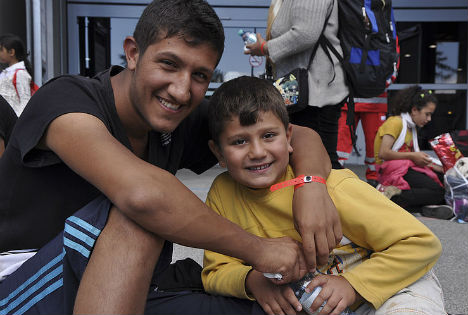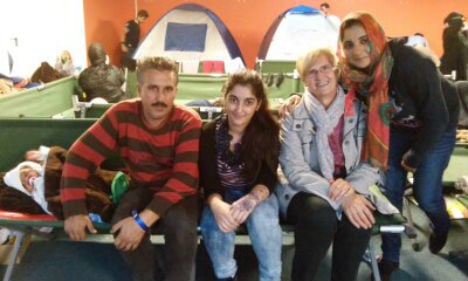The camp, which can accommodate up to 3,000 people, has been closed during the construction of a border fence at Spielfeld, but is expected to reopen in the next few days, with thousands of refugees and migrants predicted to cross into Styria on a daily basis.
“People are traumatized and weak when they arrive,” Angela said. She described their empty eyes, and said that some refugees are aggressive and in pain. Some have open wounds or broken bones – especially broken arms. There are a lot of old people using crutches and wheelchairs.
New arrivals from Syria, Afghanistan and Iraq are greeted by between five and ten translators and up to 50 Red Cross and Caritas volunteers who give out blankets as well as toys for the children.
Sick and injured people, the elderly and children are the highest priority. Every refugee is allocated a cot to sleep in, and given hygiene products and clothes. The showers and toilets are in containers in front of the hall.
Food is provided twice a day. In the morning the refugees get three slices of toast, butter and jam. In the evening they can choose a hot meal such as a goulash soup or tuna pasta.
People living at the camp are allowed to move freely and can leave the camp as they please. But Angela says that one problem is that there is nothing for them to do. Some adults play football with the children, others go for walks, play cards and start work on learning German.
Another popular activity is something the refugees call “going shopping”. Many of them have not had any new clothes for weeks but at the transit camp they have access to clean clothes which have been donated. “When you give them clothes, you try to pick some in their favourite colours or in a style that would fit them. In return you get a big smile. It’s about small things like this,” Angela said, with a smile of her own.
But a feeling of misery, heartbreak and desperation remains. “These people have been through so much trouble to get to Europe, but they always make an effort to start a conversation – asking ‘How are you?’” Angela said. “And when you take your time to listen, they slowly start talking.”
One story which stands out for her is that of a young couple. One of them lost their mother on the journey to Austria. She was diabetic but they were not able to get the right medication for her – and she died before they could reach Austria.

Youngsters at the camp. Photo: Caritas
Angela has has spoken to parents who lost their children, men whose families are still in Syria, and children and teenagers who are travelling on their own.
When Angela had only been working at the camp for a few weeks a young woman arrived with her newborn baby. The woman had given birth in Greece and she still had blood all over her clothes – she had not had a chance to change or to clean herself during her journey to Austria.
Angela was one of the first people the woman allowed to hold her newborn and said that they were immediately given medical care and are now both in good health. “You remember things like this. They stay in your mind forever,” she added.
Much of her time is spent with refugee children. “You notice how quickly they change,” she said. She describes how when they first arrive they are scared, and they draw frightening images in brown and black but as the volunteers gain their trust, the children slowly start drawing more colourful pictures of the sun, birds and flowers. Some children even paint the Austrian flag in red and white.
“Everyone is very thankful,” Angela said, adding that she admires how patient the refugees have been. At busy times, when bus loads of people arrive in Webling, they have to wait for hours before they are able to get back to their beds because the halls need to be tidied and sterilized, but Angela says there are no complaints.
“These refugees are searching for acceptance, respect, for a future but most of all, they are looking for peace,” Angela said. She hopes that they will be able to integrate into Austrian life, learn German and get to know our culture and traditions.
“No border fences can prevent more refugees from entering our countries. People are on the move and it has reached the point where they cannot be stopped anymore,” she believes. For her, it’s clear. “We have to be ready to give them a home.”
Despite the volunteers’ efforts there is an atmosphere of uncertainty in the transit camp. Questions like “When will we be able to continue our journey?” are heard on a daily basis. “It is tiring,” Angela says sadly. “Sometimes you just have no answers to their questions.”
“It’s not an easy task. You take the experiences home with you – and dream about what happened throughout the day. But, nevertheless it’s a beautiful job. I want to give people their dignity back – even if it’s just for a few hours.”
By Theresa Vogrin



 Please whitelist us to continue reading.
Please whitelist us to continue reading.